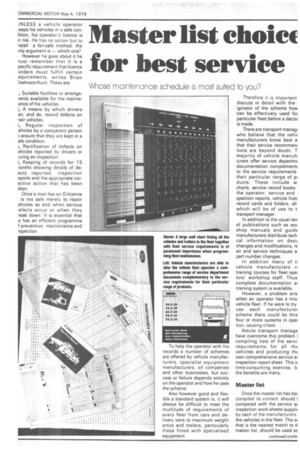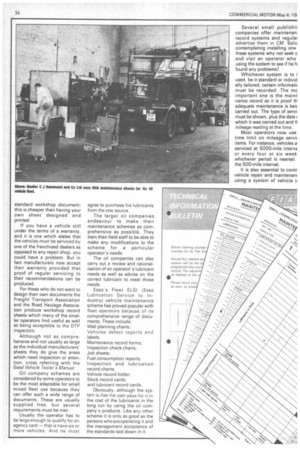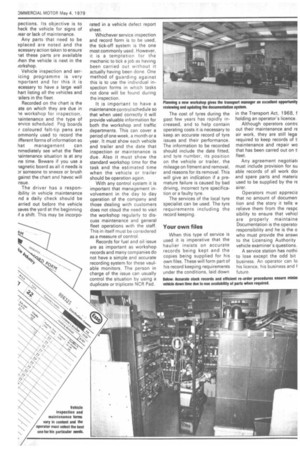Master list choice for best service
Page 35

Page 36

Page 37

If you've noticed an error in this article please click here to report it so we can fix it.
Whose maintenance schedule is most suited to you?
JNLESS a vehicle operator Reps his vehicles in a safe conlition, his operator's licence is it risk. He has no option but to istall a fail-safe method: the inly argument is — which one?
However he goes about it he lust remember that it is a pecific requirement that licence iolders must fulfill certain equirements, writes Brian :halmers-Hunt. These are.
, Suitable facilities or arrangelents available for the mainteance of his vehicles.
!, A means by which drivers an, and do, record defects on leir vehicles
I, Regular inspection of ehicles by a competent person D ensure that they are kept in a afe condition.
Rectification of defects on ehicles reported by drivers or uring an inspection.
i, Keeping of records for 15 lonths showing details of deects reported, inspection ports and the appropriate corective action that has been 3 ken.
Once a man has an 0-licence is not safe merely to repair ehicles as and when serious efects occur or when they reak down. It is essential that e has an efficient programme I preventive maintenance and lspection. To help the operator with his records a number of schemes are offered by vehicle manufacturers, specialist equipment manufacturers, oil companies and other businesses, but success or failure depends entirely on the operator and how he uses the scheme.
Also however good and flexible a standard system is, it will always be difficult to meet the multitude of requirements of every fleet from cars and delivery vans to maximum weight artics and trailers, particularly these fitted with specialised equipment. Therefore it is important discuss in detail with the iginator of the scheme how can be effectively used foi particular fleet before a decisi is made.
There are transport managi who believe that the vehil manufacturers know best a that their service recommenc tions are beyond doubt. T majority of vehicle manufE turers offer service departmE documentation complement to the service requirements their particular range of pi ducts. These include w charts, service record books • the operator, service and spection reports, vehicle hist( record cards and folders, all which will be of use to t transport manager.
In addition to the usual ran of publications such as we shop manuals and guidE manufacturers distribute tech cal information on desii changes and modifications, rt air and service techniques ai owl number changes.
In addition many of tl vehicle manufacturers ri training courses for fleet opei tors' workshop staff. Thus complete documentation ai training system is available.
However, a problem aris when an operator has a mix, vehicle fleet. If he were to try use each manufacturer scheme there could be thre four or more systems in opei /ion, causing chaos .
Astute transport manage have overcome this problem I compiling lists of the servi requirements for all thE vehicles and producing thE own comprehensive service al inspection report sheet. This time-consuming exercise, b the benefits are many.
Master list Once the master list has bei compiled its content should I compared with the service al inspection work-sheets supplii by each of the manufacturers the vehicles in the fleet. The oi that is the nearest match to tl master list, should be used as
standard workshop document; this is cheaper than having your own sheet designed and printed.
If you have a vehicle still under the terms of a warranty, and it is one which states that the vehicles must be serviced by one of the franchised dealers as opposed to any repair shop, you could have a problem. But in fact manufacturers now accept their warranty provided that proof of regular servicing to their recommendations can be produced.
For those who do not want to design their own documents the Freight Transport Association and the Road Haulage Association produce workshop record sheets which many of the smaller operators find useful as well as being acceptable to the DTP in Although not as comprehensive and not usually as large as the individual manufacturers' sheets they do give the areas which need inspection or attention, cross referring with the Good Vehicle Tester's Manual.
Oil company schemes are considered by some operators to be the most adaptable for small mixed fleet use because they can offer such a wide range of documents. These are usually supplied free, but several requirements must be met.
Usually the operator has to be large enough to qualify for an agency card — that is have six or more vehicles. And he must agree to purchase his lubricants from the one source.
The larger oil companies endeavour to make their maintenance schemes as comprehensive as possible. They train their field staff to be able to make any modifications to the scheme for a particular operator's needs.
The oil companies can also carry out a review and rationalisation of an operator's lubricant needs as well as advise on the correct lubricant to meet those needs.
Esso's Fleet ELS! (Esso Lubrication Service to Industry) vehicle maintenance scheme has proved popular with fleet operators because of its comprehensive range of documents. These include: Wall planning charts; Vehicles defect reports and labels; Maintenance record forms; Inspection check charts; Job sheets; Fuel consumption reports; Inspection and lubrication record charts; Vehicle record folder; Stock record cards; and lubricant record cards.
Obviously, although the system Is free the user pays for it in the cost of the lubricants in the long run by using the oil company's products. Like any other scheme it is only as good as the persons who areoperating it and the management acceptance of the standards laid down in it. Several small publishir companies offer maintenan record systems and regular advertise them in CM. Befo contemplating installing one these systems why not seek a and visit an operator who using the system to see if he h found any problems?
Whichever system is to I used, be it standard or individ ally tailored, certain informatir must be recorded. The ma important one is the maint nance record as it is proof th adequate maintenance is beir carried out. The type of servil must be shown, plus the date which it was carried out and ti mileage reading at the time.
Most operators now use time limit on mileage servic items_ For instance, vehicles a serviced at 5000-mile interva or every four or six week whichever period is nearest the 500-mile interval.
It is also essential to contr vehicle repair and maintenanc using a system of vehicle ii pections. Its objective is to heck the vehicle for signs of tear or lack of maintenance,
Any parts that need to be splaced are noted and the ecessary action taken to ensure -hat these parts are available then the vehicle is next in the torkshop.
Vehicle inspection and sericing programme is very nportant and for this it is ecessary to have a large wall hart listing all the vehicles and -ailers in the fleet.
Recorded on the chart is the ate on which they are due in le workshop for inspection, laintenance and the type of ervice scheduled. Peg boards r coloured felt-tip pens are ommonly used to record the ifferent forms of information so hat management ca n nmediately see what the fleet laintenance situation is at any fle time. Beware if you use a iagnetic board as all it needs is Dr someone to sneeze or brush gainst the chart and havoc will nsue.
The driver has a responibility in vehicle maintenance nd a daily check should be arried out before the vehicle saves the yard at the beginning if a shift. This may be incorpo
rated in a vehicle defect report sheet.
Whichever service inspection and record form is to be used, the tick-off system is the one most commonly used. However, it is a temptation for the mechanic to tick a job as having been carried out without it actually having been done. One method of guarding against this is to use the individual inspection forms in which tasks not done will be found during the inspection.
It is important to have a maintenance control schedule so that when used correctly it will provide valuable information for both the workshop and traffic departments. This can cover a period of one week, a month or a year. ft must show each vehicle and trailer and the date that inspection or maintenance is due. Also it must show the standard workshop time for the task and the estimated time when the vehicle or trailer should be operation again.
With any control system it is important that management involvement in the day to day operation of the company and those dealing with customers does not cloud the need to visit the workshop regularly to discuss maintenance and general fleet operations with the staff. This in itself must be considered as a measure of control.
Records for fuel and oil issue are as important as workshop records and many companies do not have a simple and accurate recording system for these vaulable monitors. The person in charge of the issue can usually control the situation by using a duplicate or triplicate NCR Pad, The cost of tyres during the past few years has rapidly increased, and to help contain operating costs it is necessary to keep an accurate record of tyre issues and their performance. The information to be recorded should include the date fitted, and tyre number, its position on the vehicle or trailer, the mileage on fitment and removal, and reasons for its removal. This will give an indication if a premature failure is caused by bad driving, incorrect tyre specification or a faulty tyre.
The services of th.e local tyre specialist can be used. The tyre requirements including the record keeping.
Your own files
When this type of service is used it is imperative that the haulier insists on accurate records being kept and the copies being supplied for his own files. These will form part of his record keeping requiremeats under the conditions, laid down in the Transport Act, 1968, f holding an operator's licence.
Although operators contra out their maintenance and re air work, they are still lega required to keep records of tl maintenance and repair wo that has been carred out on tl fleet.
Any agreement negotiatf must include provision for su able records of all work doi and spare parts and materie used to be supplied by the re airer.
Operators must apprecia that no amount of documen tion and the story it tells v‘ relieve them from the respc sibility to ensure that vehicl are properly maintaine Documentation is the operato responsibility and he is the o who must provide the answi to the Licensing Authority vehicle examiner's questions.
A service station has nothil to lose except the odd bit business. An operator can lo his licence, his business and f future.
























































































































